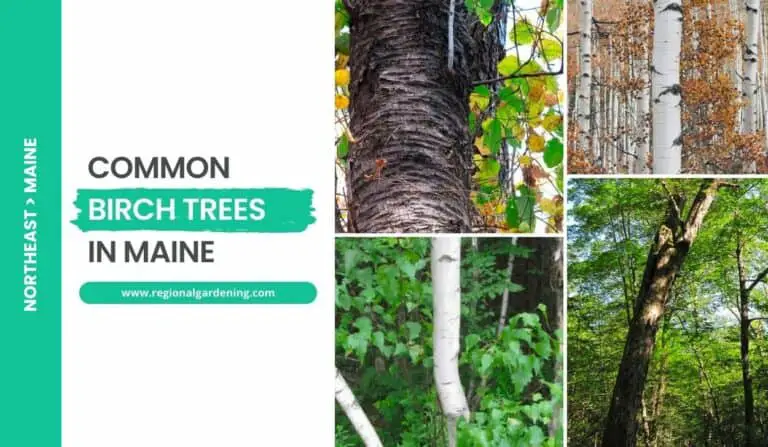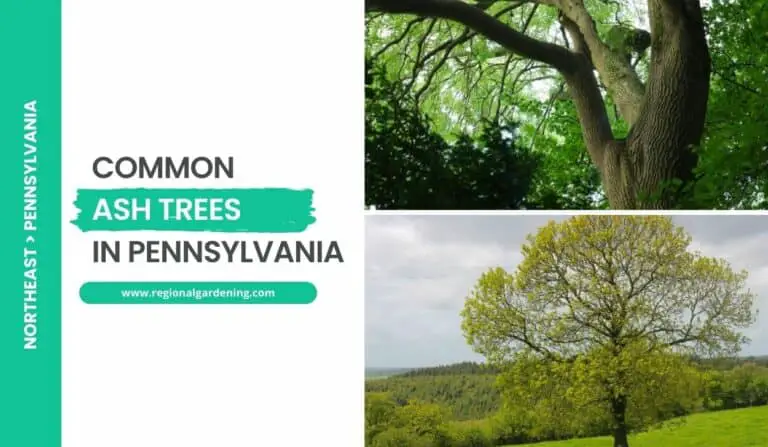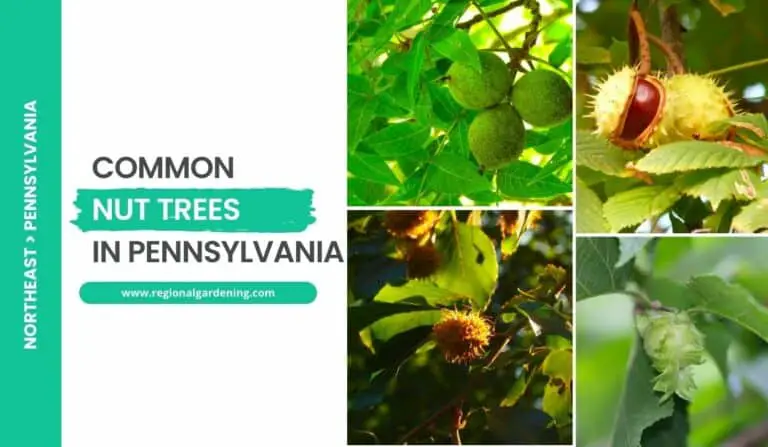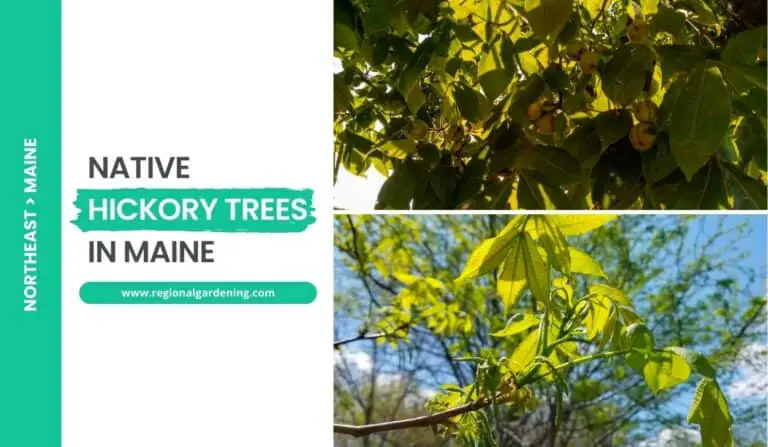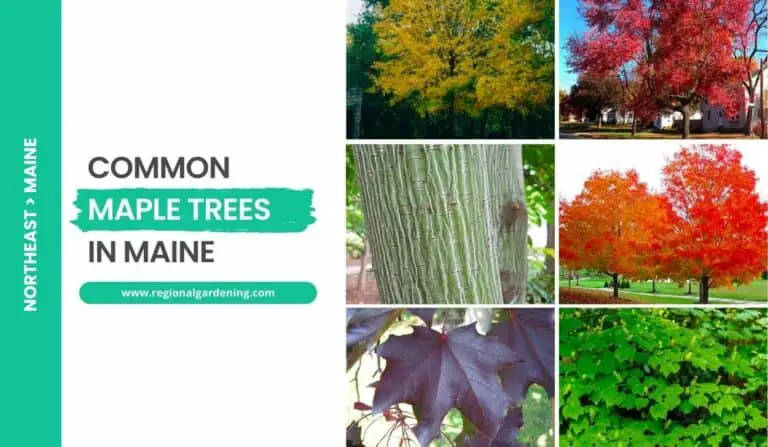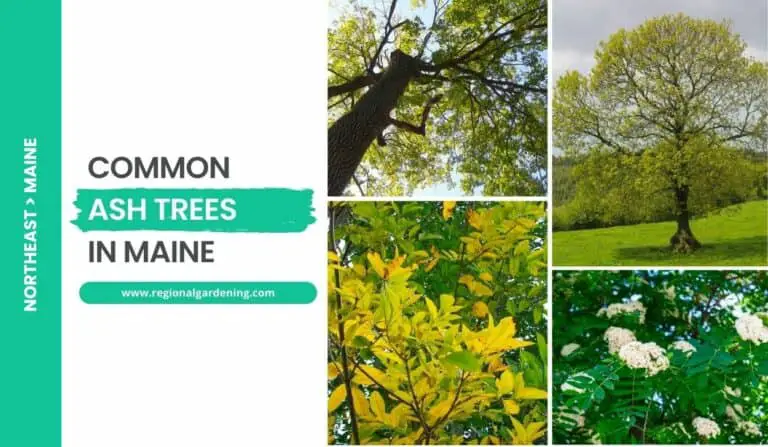9 White Flowering Trees In Pennsylvania (Photos & Identification)
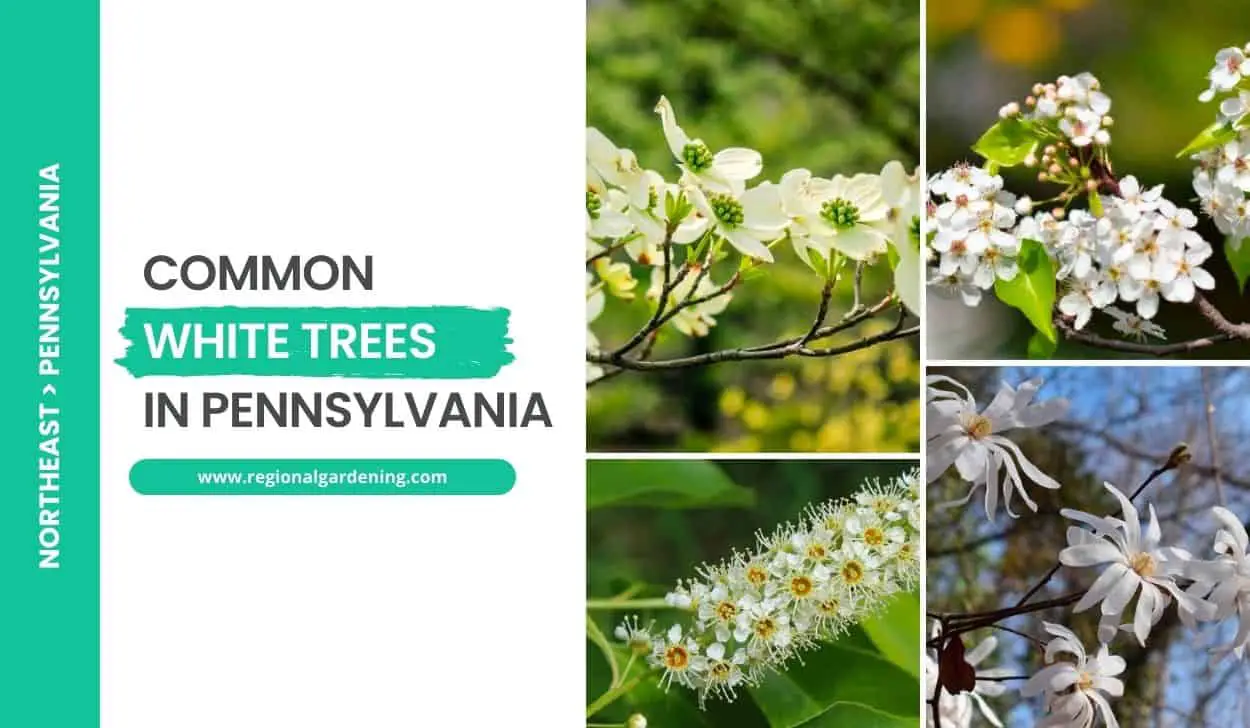
Pennsylvania is home to a wide variety of flowering trees thanks to the state’s beautiful scenery and changing seasons.
In this group, the white flowering trees stand out because of the enchanting effect their flowers have. These trees are more than just an aesthetic addition to parks and gardens; they represent sophistication and innocence as well. Each white flowering tree, from the captivating dogwood to the graceful magnolia, has its distinct charm.
In this article, we will learn about nine different types of beautiful white flowering trees in Pennsylvania, including their unique traits, practical applications, and interesting histories.
Let’s begin.
1. Flowering Dogwood
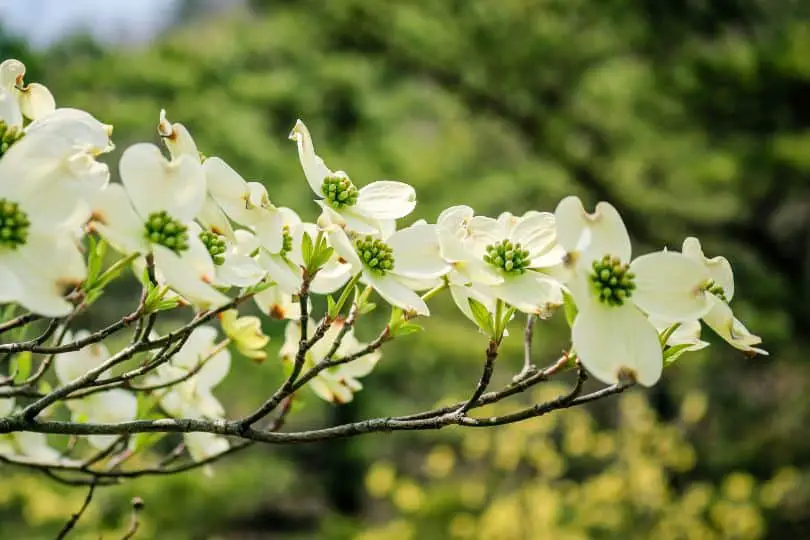
- Scientific Name: Cornus florida
- Common Name(s): Flowering Dogwood, American Dogwood
- Mature Height: 20-40 feet (6-12 meters)
- Native Region: Eastern United States
- Flowers: White, four-petaled flowers
- Fruit: Bright red berries
- Uses: Ornamental tree, wildlife habitat, erosion control, medicinal uses (bark and fruit)
Flowering Dogwood is a small to medium-sized deciduous tree native to eastern North America, including Pennsylvania. It grows to a mature height of 20-40 feet (6-12 meters) with a broad, rounded canopy.
The tree is well-known for its magnificent white blooms that bloom in the spring and have four enormous petals that are frequently mistaken for petals. The blossoms are followed by brilliant red berries, which attract birds and other wildlife.
Flowering Dogwood is a popular decorative plant in Pennsylvania settings due to its lovely blossoms and fall leaves. It enjoys partial shade to full sun and grows best in well-drained, acidic soil. This tree is low-maintenance, although it does need to be watered regularly, especially during dry seasons, to establish and maintain healthy development.
Flowering Dogwood can be found in wooded areas and along forest margins. It is frequently utilized in landscaping to give shade and beautify gardens, parks, and residential areas. The tree’s dense, horizontal branches and rough bark make it a good choice for attracting wildlife and adding aesthetic interest.
Flowering Dogwood is also recognized for its therapeutic benefits. Traditional medicine has employed the tree’s bark and fruit to cure colds, fevers, and respiratory problems.
2. Black Cherry
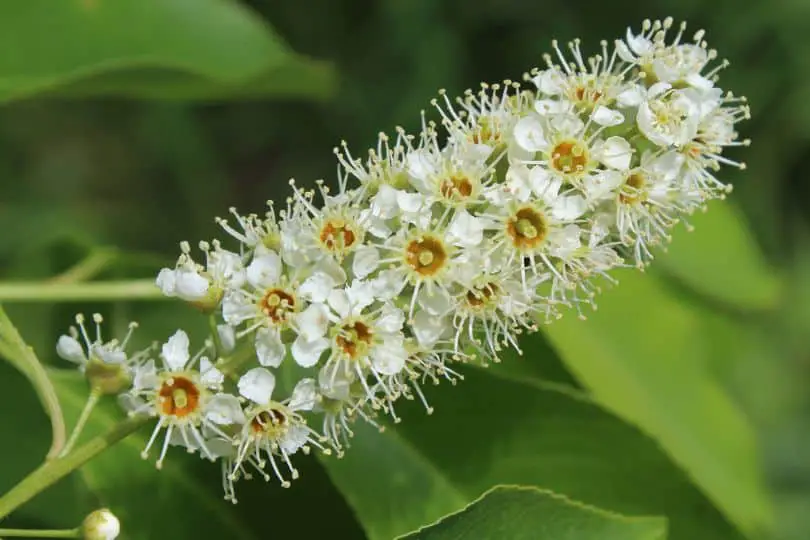
- Scientific Name: Prunus serotina
- Common Name(s): Black Cherry, Wild Cherry
- Mature Height: 50-80 feet (15-24 meters)
- Native Region: North America
- Flowers: White, small clusters of blossoms in spring
- Fruit: Dark red to black cherries
- Uses: Black Cherry wood is highly valued for furniture making, cabinetry, and flooring. The fruit is edible and commonly used in pies, preserves, and beverages. The bark and leaves have medicinal properties and are used in traditional remedies.
The Black Cherry, also known as Prunus serotina, is a North American deciduous tree. It can mature to a height of 50-80 feet and a spread of 25-40 feet. The tree has a strong central leader and has a conical to round-shaped crown. With fine-textured twigs, the branches are slender and rising.
Black Cherry leaves are elliptical, dark green in color, and have coarsely serrated edges. They change yellow to red in the fall, lending a vivid accent to the environment. When young, the tree’s bark is smooth and reddish-brown, but it later turns dark and scaly.
In late April, black cherries bloom, producing little clusters of white flowers. Pollinators such as bees and butterflies feed on nectar from these blooms. The tree produces dark crimson to black cherries later in the summer, which are popular with birds and other wildlife. The fruit is also edible to humans and can be utilized in a variety of culinary dishes.
Black Cherries can be found in several environments in Pennsylvania, including forests, forest edges, and disturbed areas. They love moist, well-drained soils and full sun, but will take partial shade as well. These trees may grow in a variety of soil types, including loamy, sandy, and clay.
Black Cherries in Pennsylvania settings may benefit from pruning to maintain a balanced shape and to eliminate dead or diseased branches. Watering is essential regularly during dry months, especially for young trees. Furthermore, spreading organic mulch around the tree’s base can assist in conserving moisture and controlling weeds.
Black Cherry wood is highly prized in the timber sector, aside from its ornamental appeal. It has a deep reddish-brown hue that darkens over time and is robust and fine-grained. The wood is often utilized in the manufacture of furniture, cabinetry, and flooring. The cherries themselves are prominent in the culinary world and are frequently used in pies, preserves, and beverages.
Furthermore, the Black Cherry bark and leaves have a long history of therapeutic use. They contain chemicals that are anti-inflammatory and anti-cancer. Native Americans employed several portions of the tree to treat coughs, colds, and intestinal problems. It should be noted, however, that using any plant material for therapeutic purposes should be done under the supervision of a trained healthcare expert.
3. Star Magnolia
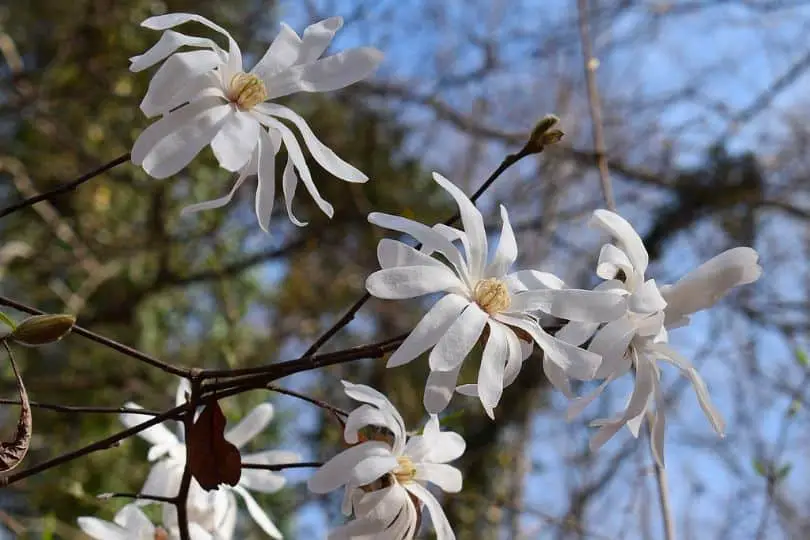
- Scientific Name: Magnolia stellata
- Common Name(s): Star Magnolia
- Mature Height: 10 to 20 feet (3 to 6 meters)
- Native Region: Asia
- Flowers: Showy, star-shaped flowers that are usually white or pale pink
- Fruit: Cone-like fruits that contain red seeds
- Uses: Ornamental tree, popular for its beautiful flowers in landscaping, good for small gardens, or as a focal point in larger landscapes.
The Star Magnolia (Magnolia stellata) is a deciduous tree endemic to Asia. It is well-known for its brilliant, star-shaped flowers that bloom in early spring. The flowers range in color from white to pale pink and make for an impressive spectacle. The Star Magnolia, with a mature height of 10 to 20 feet, is ideal for smaller gardens or as a focal point in larger landscapes.
The Star Magnolia is distinguished by its spreading, spherical crown, and thick, dark green foliage. The leaves are obovate, which means they are wider at the top and taper down to the base. The tree’s bark is smooth and grayish-brown in color.
The Star Magnolia, a native of Asia, thrives in Pennsylvania’s environment. It prefers full sun to light shade and thrives in well-draining, wet soils. This tree is low-maintenance, requiring only frequent watering during dry spells and occasional trimming to keep its shape.
The Star Magnolia is primarily grown for its magnificent flowers, which bloom in early spring and are a pleasure to behold. These blooms are not only gorgeous but also fragrant, infusing the air with a pleasant aroma. The tree has cone-shaped fruits with crimson seeds, which can add aesthetic interest to the landscape.
The Star Magnolia is a popular ornamental tree in both residential and business landscapes in Pennsylvania. Because of its tiny stature, it is ideal for planting in small gardens or as an accent tree. In early spring, the tree’s spectacular blossoms make it a popular choice for establishing a focal point and bringing color to the environment.
To care for Star Magnolias in Pennsylvania, put them in well-draining soil and water them regularly, especially during dry months. Pruning should take place in late winter or early spring, before the tree blooms. This will help the tree keep its shape and promote healthy growth.
4. Ornamental Pear

- Scientific Name: Pyrus calleryana
- Common Name(s): Ornamental Pear, Bradford Pear, Cleveland Select Pear
- Mature Height: 30-50 feet (9-15 meters)
- Native Region: China and Vietnam
- Flowers: White, clustered, five-petaled flowers in early spring.
- Fruit: Small, round, greenish-brown pears inedible for humans but attractive to birds.
- Uses: This tree is commonly used as an ornamental tree in landscapes due to its attractive flowers and foliage. It is also utilized for its natural pyramid shape and ability to withstand urban pollution and compacted soil.
The Ornamental Pear, technically known as Pyrus calleryana, is a deciduous tree with a mature height of 30-50 feet (9-15 meters). It has a dense, symmetrical crown and a moderate growth rate. The glossy, oval-shaped leaves of the Ornamental Pear have a serrated border and develop a gorgeous purple color in the fall.
Because of its magnificent spring flowers, the Ornamental Pear, which is native to China and Vietnam, has become a favorite choice for landscaping in Pennsylvania and other areas. The tree produces clusters of white, five-petaled flowers that cover the branches in early April. The blossoms stand out against the dark green foliage of the tree.
In addition to its lovely blossoms, the Ornamental Pear bears small, spherical pearls. Although these fruits are not edible to humans, they are appealing to birds and can add visual interest to the tree. When young, the bark is grayish-brown and smooth, gradually acquiring shallow horizontal ridges as it ages.
It is critical to pick a spot with full sun exposure and well-drained soil when growing the Ornamental Pear in Pennsylvania landscaping. This tree can survive a wide range of soil types, including clay and sandy soil. It is particularly well-known for its resistance to urban pollutants and compacted soil, making it ideal for planting in residential settings.
During the first few years of growth, the Ornamental Pear requires constant irrigation to build its root system. It can withstand periods of drought once planted. Pruning should be done in late winter or early spring to keep the shape of the tree and to remove any dead or diseased limbs.
Because of its dense leaves, the Ornamental Pear has been used for erosion control and windbreaks in addition to being an ornamental tree in landscapes. It is crucial to note, however, that the tree is prone to breaking in strong gusts, thus adequate maintenance and pruning are required.
5. Hawthorn
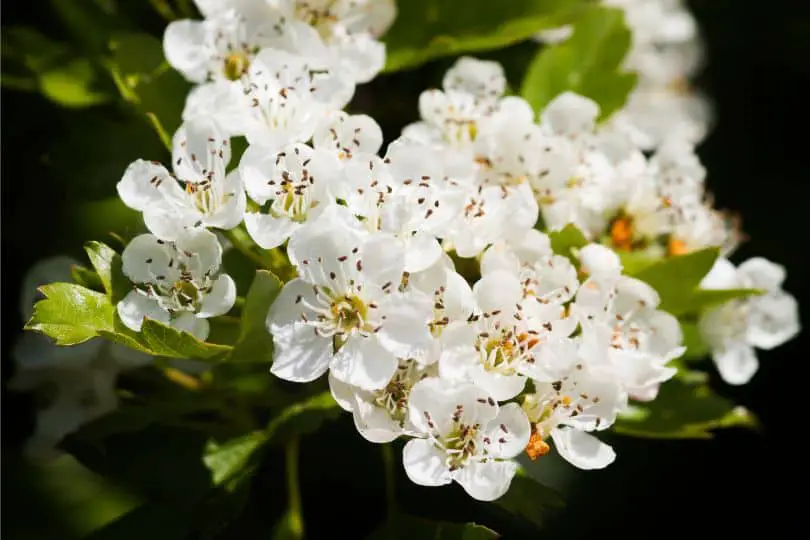
- Scientific Name: Crataegus spp.
- Common Name(s): Hawthorn
- Mature Height: Varies depending on the species, generally between 15-40 feet (4.5-12 meters)
- Native Region: North America, Europe, Asia, and Africa
- Flowers: White or pink, with five petals and a central cluster of stamens
- Fruit: Small red or blackberries
- Uses: Ornamental tree, wildlife habitat, medicinal uses, and folklore
Hawthorn trees from the genus Crataegus are abundant in Pennsylvania settings. They are small to medium-sized deciduous trees with mature heights ranging from 15 to 40 feet (4.5 to 12 meters) depending on species. Hawthorn trees can be found in North America, Europe, Asia, and Africa.
These trees have unique traits that make them attractive landscape additions. Their thorny branches and lobed leaves form a thick canopy. With age, the bark becomes gray and develops shallow fractures. Hawthorns have five petals and a cluster of stamens in the center of their blossoms. Some hawthorn species have aromatic blooms. They bear little red or black berries in late summer and fall, which are popular with birds and other wildlife.
Hawthorns are typically found in open forests, woodland borders, and along streams in its natural region. They prefer well-drained soil but may grow in a variety of soil conditions, including clay. It is critical to select a species that is appropriate for the local climate and soil conditions when planting hawthorn trees in Pennsylvania.
Hawthorns offer a wide range of use in the landscape and beyond. Because of their lovely flowers and berries, which can provide color and visual appeal to landscapes, they are frequently planted as ornamental trees. Hawthorns also provide a home for birds and other creatures. When planted as hedgerows, several hawthorn species have thorns that might dissuade unwelcome visitors or act as natural barriers.
Hawthorn trees have been utilized in traditional medicine for generations, in addition to their aesthetic and ecological significance. The leaves, flowers, and berries have been utilized to enhance heart health because of their cardiovascular health advantages. However, before consuming hawthorn for therapeutic purposes, visit a healthcare practitioner.
Hawthorn trees are related to a variety of rituals and superstitions in folklore. They are frequently seen as symbols of protection, fertility, and good fortune. Hawthorns are associated with fairies in some cultures and are said to have supernatural abilities.
Regular pruning of hawthorn trees in Pennsylvania can assist in maintaining their shape and promote maximum growth. To avoid pest infestations or further damage, dead, damaged, or diseased branches should be removed. Furthermore, supplying appropriate hydration during dry months and frequent fertilization can assist in ensuring the tree’s health and vitality.
6. Serviceberry
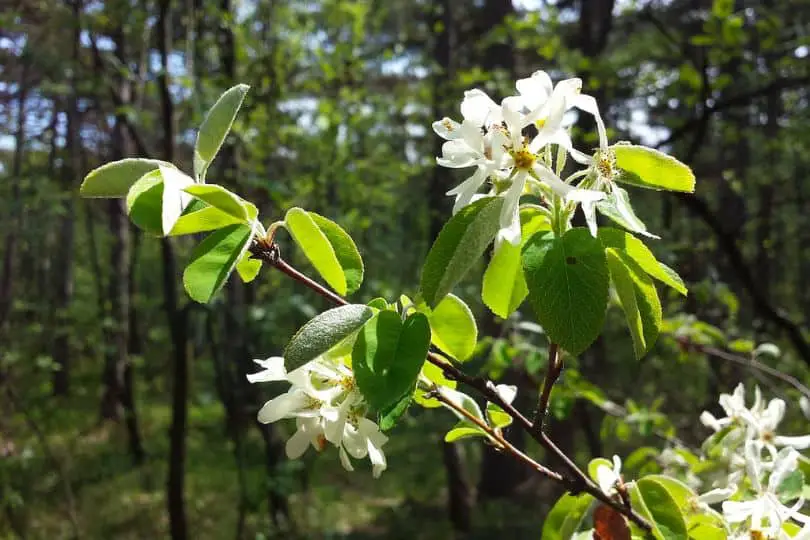
- Scientific Name: Amelanchier spp.
- Common Name(s): Serviceberry, Juneberry
- Mature Height: 15-25 feet (4.5-7.6 meters)
- Native Region: North America
- Flowers: White, star-shaped flowers
- Fruit: Edible, dark purple berry-like fruits
- Uses: Ornamental tree, wildlife habitat, edible fruit, erosion control
The Serviceberry (Amelanchier spp.) is a tiny deciduous tree or shrub that is abundant in Pennsylvania landscapes. It grows to a mature height of 15 to 25 feet (4.5 to 7.6 meters) and creates a multi-stemmed cluster, making it an ideal choice for naturalizing or adding interest to the garden.
Serviceberries are native to North America and thrive in the climate of Pennsylvania. They love moist, well-drained soil and grow in full sun to partial shade. These trees are well-known for their showy display of white, star-shaped flowers in early spring, which give way to dark purple berry-like fruits that are edible and popular with both humans and wildlife.
Serviceberries have oval-shaped leaves that emerge golden to green before changing yellow to orange in the fall. The tree’s smooth gray bark contributes to its visual appeal. Serviceberries are popular as ornamentals because they have a delicate beauty that lasts through the seasons.
Serviceberries have various functional uses aside from their visual attractiveness. The fruits can be gathered and eaten fresh or used in pies, jams, and jellies. The tree also serves as an important food source for birds and other species. Serviceberries also have a strong root system that helps with erosion prevention, making them an excellent choice for planting on slopes or along stream banks.
It is critical to offer frequent irrigation to Serviceberries in Pennsylvania landscapes, especially during dry years. Mulching around the tree’s base can assist in preserving moisture and inhibit weed growth. Pruning should be performed in late winter or early spring to remove dead or broken branches and, if desired, shape the tree.
7. Black Locust
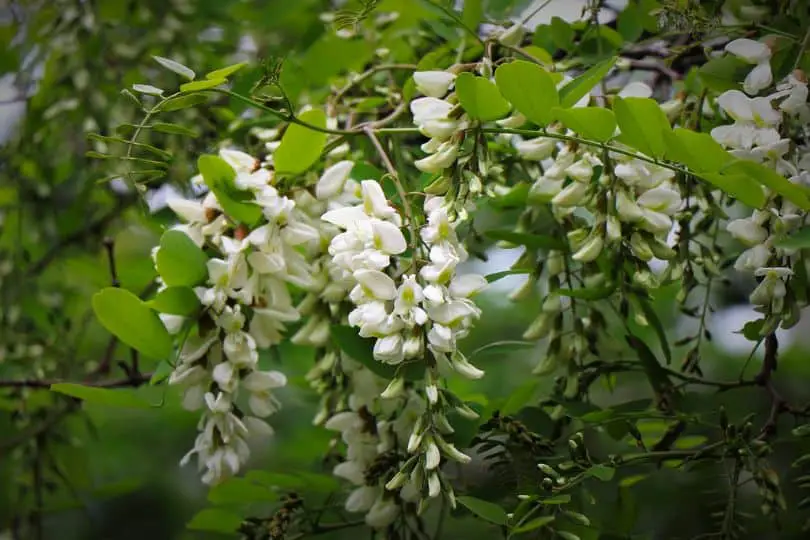
- Scientific Name: Robinia pseudoacacia
- Common Name(s): Black Locust, False Acacia
- Mature Height: 30-70 feet (9-21 meters)
- Native Region: North America
- Flowers: White, fragrant, pea-like flowers.
- Fruit: Flat, brown seed pods.
- Uses: Black Locust is often used for timber, fence posts, and erosion control due to its strength and durability.
The Black Locust (Robinia pseudoacacia), sometimes known as False Acacia, is a North American deciduous tree. It matures to a height of 30-70 feet (9-21 meters) and has a narrow, pyramidal shape while young, acquiring a more rounded crown as it ages.
This tree is well-known for its beautiful compound leaves, which are made up of small, oval-shaped leaflets. The leaves are bright green in hue and turn golden before dropping in the fall. The bark of the Black Locust is dark in color and furrowed, giving the tree an intriguing texture.
Black locust is extremely adaptable and may survive in a wide range of soil conditions, including poor and rocky soils. Its ability to fix nitrogen in the soil makes it a great candidate for increasing the fertility of degraded soils. It is also drought tolerant, making it ideal for Pennsylvania landscapes.
The Black Locust blooms in late spring to early summer with clusters of fragrant, white flowers that resemble peas. These blooms are attractive to bees and other pollinators and supply nectar for honey production. Following the blossoms, the tree produces flat, brown seed pods that are not particularly attractive but provide food for birds.
The Black Locust can be used as a shade tree or as a windbreak in Pennsylvania landscapes. Because of its strength and durability, it is a popular choice for lumber, fence posts, and other building needs. Because of its vast root system and capacity to grow in difficult environments, it is also utilized for erosion control.
It is recommended to provide full sun exposure and well-drained soil while caring for a Black Locust tree in Pennsylvania. Watering the tree regularly, especially during dry months, can help it develop and grow. Pruning may be required to keep the ideal shape and to eliminate any dead or unhealthy branches.
8. Japanese Stewartia
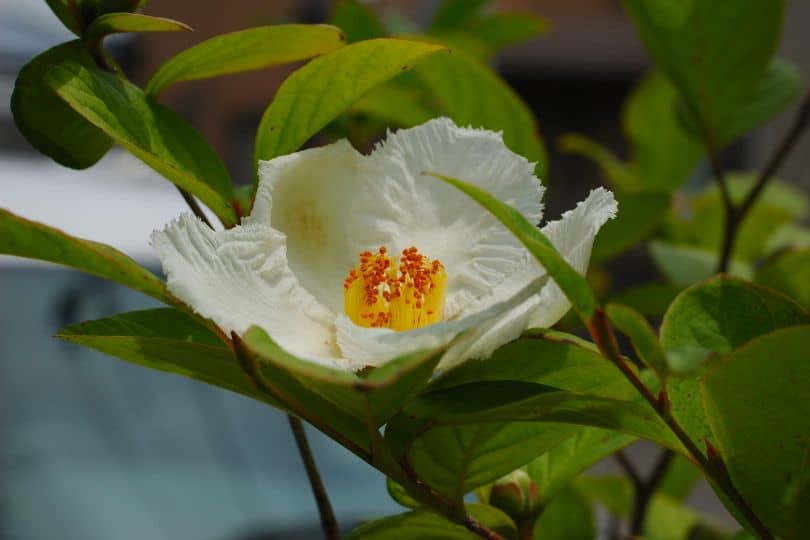
- Scientific Name: Stewartia pseudocamellia
- Common Name(s): Japanese Stewartia
- Mature Height: 20-40 feet (6-12 meters)
- Native Region: Japan, Korea
- Flowers: White, camellia-like flowers
- Fruit: Small, brown capsule with seeds
- Uses: Ornamental tree, shade tree, specimen tree, garden tree
Japanese Stewartia, formally known as Stewartia pseudocamellia, is a lovely and popular tree that may be found throughout Pennsylvania. It is a deciduous tree that can grow to be 20-40 feet (6-12 meters) tall when mature. This tree is native to Japan and Korea, and it is prized for its beautiful white blooms and appealing bark.
Japanese Stewartia leaves are glossy green, oblong in shape, and have serrated edges. It has smooth, reddish-brown bark that peels to reveal a mosaic-like pattern of gray, cream, and reddish-brown patches, making it a fascinating feature all year. The overall structure of the tree is elegant and small, making it an appealing choice for gardens and landscapes.
The Japanese Stewartia has spectacular white flowers that resemble camellias in early summer, hence the name pseudocamellia. These flowers are incredibly decorative and bring a touch of refinement and charm to the tree. During the fall season, little brown capsules with seeds appear after the flowers. These capsules give interest to the tree and can last into the winter, adding visual appeal.
Japanese Stewartia in Pennsylvania settings should be planted in well-drained soil with a neutral pH level. It thrives in a range of lighting conditions, from partial shade to full sun. Watering is required regularly, especially during dry months, to keep the soil constantly hydrated. Mulching around the tree aids in moisture retention and temperature regulation.
This tree is widely utilized as an ornamental tree, enhancing the beauty and aesthetic value of gardens and landscapes. It can be planted as a shade tree or as a specimen tree, attracting attention and creating focal points. Japanese Stewartia can also be cultivated in pots or as a multi-stemmed shrub.
9. Fire Cherry
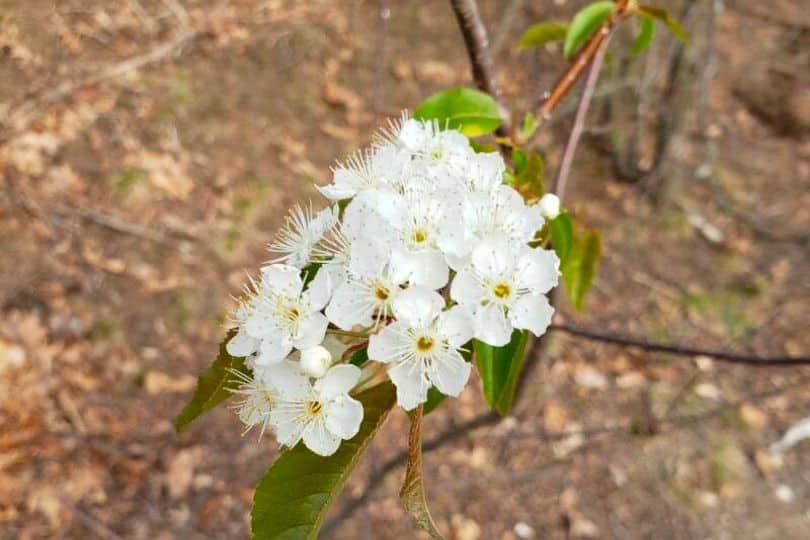
- Scientific Name: Prunus pensylvanica
- Common Name(s): Fire Cherry, Pin Cherry
- Mature Height: 20-40 feet (6-12 meters)
- Native Region: North America
- Flowers: White flowers clustered in upright racemes
- Fruit: Small red cherries
- Uses: Erosion control, wildlife habitat, ornamental tree
Prunus pensylvanica, also known as the Fire Cherry, is a deciduous tree endemic to North America. Pin Cherry is another common name for it. This tree has an upright, slender growth style and can reach a mature height of 20-40 feet (6-12 meters). The Fire Cherry is well-known for its lovely white blooms, which bloom in tall racemes in the spring and attract pollinators.
The Fire Cherry leaves are oval, with slightly serrated edges and a glossy green tint. They turn a vivid crimson or yellow in the fall, creating a stunning display of autumn hues. When young, the tree’s bark is smooth and reddish-brown, but as it matures, it develops horizontal stripes and darkens in color.
The Fire Cherry can be found in open fields, clearings, and woodland edges in its natural area. It favors moist, well-drained soils, but may endure dry and sandy conditions as well. Because this tree is flexible and can grow in both full sun and partial shade, it is appropriate for a wide range of Pennsylvania landscapes.
The Fire Cherry yields little red cherries when the flowering phase is ended. Even though people don’t typically eat these cherries due to their bitter flavor, they are a vital source of food for many different animal species, including birds, small mammals, and butterflies. Because of its lush foliage and profusion of fruit, the tree is an excellent choice for establishing wildlife habitat.
Because of its capacity to grow quickly and create a robust root structure, the Fire Cherry is often utilized for erosion control in Pennsylvania landscapes. It’s also popular as a decorative tree, giving beauty and interest to gardens and landscapes. Once established, this tree requires little attention; nevertheless, it benefits from regular irrigation during seasons of drought.
Similar Articles
- Common Flowering Trees In Pennsylvania
- Common Maple Trees In Pennsylvania
- Common Cherry Trees In Pennsylvania
- Common Pine Trees In Pennsylvania
- Native Locust Trees In Pennsylvania
- Common Nut Trees In Pennsylvania
- Common Cedar Trees In Pennsylvania
- Common Palm Trees In Pennsylvania
- Common Birch Trees In Pennsylvania
- Common Aspen Trees In Pennsylvania
- Common Oak Trees In Pennsylvania
- Common Ash Trees In Pennsylvania
- Common Elm Trees In Pennsylvania
- Common Spruce Trees In Pennsylvania
- Pink Flowering Trees In Pennsylvania
- Purple Flowering Trees In Pennsylvania
Common White Flowering Trees In Pennsylvania – Sources
The Regional Gardening team makes sure that the information in our articles is accurate by only using sources that are known to be trustworthy. Some of these sources are peer-reviewed journals from government agencies, well-known universities, and scientific research organizations.
- Native Plant Resources, Pennsylvania Native Plant Society
- Trees & Shrubs Varieties, PennState Extension
- Landscaping With Natives, Pennsylvania Department Of Conservation, & Natural Resources.
- Explore Pennsylvania Forests, Pennsylvania Department Of Conservation, & Natural Resources.


